Periodontitis combined with smoking increases risk of the ulcerative colitis: A national cohort study
Eun Ae Kang, Jaeyoung Chun, Jee Hyun Kim, Kyungdo Han, Hosim Soh, Seona Park, Seung Wook Hong,Jung Min Moon, Jooyoung Lee, Hyun Jung Lee, Jun-Beom Park, Jong Pil Im, Joo Sung Kim
Abstract
Key Words: Inflammatory bowel disease; Periodontitis; Smoking; Ulcerative colitis; Crohn’s disease
INTRODUCTION
Periodontitis is a chronic infectious and inflammatory disease of periodontal tissues caused by interactions between the microbiota in the root canals and the host immune system[1]. Periodontitis can be caused by a variety of etiologies, such as alveolar bone destruction, dental plaque bacteria, remnant food material, and an abnormal immune response[2]. The prevalence of periodontitis ranges from 20% to 50% globally and increases with age[3,4]. Risk factors for periodontitis, such as smoking and alcohol consumption, diabetes mellitus, obesity, and metabolic syndrome, have been reported in previous studies[5,6]. Furthermore, periodontitis is closely linked to the pathogenesis of systemic disease[7,8].
Inflammatory bowel diseases (IBD), including Crohn’s disease (CD) and ulcerative colitis (UC) are chronic relapsing inflammatory diseases of the gastrointestinal tract with many causes. Complex interactions among gut dysbiosis, changes in the host immune system, and genetic factors affect the development of IBD. In Asia, the prevalence of IBD is rapidly increasing, and its genetic predisposition and environmental impact is different from that of western countries[9]. Environmental factors such as smoking and alcohol consumption can be associated with the development of IBD. The effects of smoking on the pathogenesis of CD and UC are different. Smoking may have a minor role in the development of CD in Asia, unlike western populations[10]. In contrast, former smokers have a significantly higher risk of developing UC than non-smokers[11]. Alcohol consumption is related to exacerbation of symptoms in patients with IBD[12].
The destruction of periodontal tissues might induce activation of a variety of cytokines related to the pathophysiology of IBD[13]. In addition, changes in the gut microbiota and immunosuppressive agents used to treat IBD can deteriorate oral healthviachanges in the oral microbiota, resulting in an increased risk for periodontitis[14,15]. Periodontitis and IBD are characterized by chronic inflammation initiated in the oro-intestinal tract, and share a number of similar pathophysiological features. However, the pathogenic relationship between periodontitis and IBD remains unclear. Epidemiological studies regarding the effects of periodontitis based on age and environmental factors on the occurrence of IBD are lacking. The aims of the study were to assess the incidence and risk of IBD among patients with periodontitis and identify the risk factors for the occurrence of IBD related to periodontitis.
MATERIALS AND METHODS
Database
The National Health Insurance (NHI) service is a single, mandatory medical insurer providing a health insurance to approximately 51 million citizens in South Korea. The NHI database contains information on comorbidities, drug prescriptions, treatment, and demographic characteristics of Koreans due to the unique nature of the NHI service. The National Health Screening Program (NHSP) is conducted every 2 years for all qualified adults > 20 years of age, and the information collected by the NHSP accumulates as a separate cohort. Clinical data at baseline and trends in changes in the data can be evaluated in the cohort. The Rare and Intractable Diseases (RID) system supports additional medical costs for patients with RIDs, such as IBD. We identified the RIDs with a special diagnostic code (V code). CD is a rare disease, and UC is regarded as an intractable disease in South Korea.
Study population
This was a nationwide population-based retrospective cohort study using the NHI claims data from a population who underwent the NHSP in 2009 (index year). Patients were classified into the periodontitis group when the International Classification of Diseases (ICD)-10 code for periodontitis (K05.3) was identified at the index examination. The periodontitis group was divided into three stages according to the severity of periodontitis based on therapeutic procedures, including scaling, subgingival curettage, and surgery. Individuals without periodontitis were considered the non-periodontitis group. In both groups, patients who were diagnosed with IBD from 2004 to 2009 were excluded to rule out IBD cases not related to periodontitis (washout period). Newly diagnosed IBD patients in the first year after the index year were also excluded (lag period). Patients who were newly diagnosed with periodontitis during the follow-up period in the non-periodontitis group were censored in this study.
Definition and data acquisition
Age, sex, body mass index (BMI), waist circumference, cigarette smoking, alcohol drinking, exercise, income, comorbidities, and laboratory findings were collected in the periodontitis and non-periodontitis groups. Smoking was classified as current smoker, ex-smoker, and nonsmoker based on a questionnaire[11]. Current smokers were defined as those who had smoked more than five packs of cigarettes throughout their lives and continued cigarette smoking. Ex-smokers were defined as those who had smoked more than five packs of cigarettes but quit smoking at least 1 mo ago. Nonsmokers were defined as those who had no experience with cigarette smoking or had smoked less than five packs throughout their lifetime. Alcohol drinking was categorized into non-drinker, mild, and excessive drinker. The excessive drinker was defined as consuming more than 30 g per day of alcohol[16]. Exercise was considered ‘yes’ according to the questionnaire when the participant performed moderateintensity exercise for 30 min or vigorous-intensity exercise for 20 min at least once per week[17]. Obesity was defined as BMI > 25 kg/m2, and central obesity was defined as a waist circumference > 90 cm in males and > 85 cm in females. Hypertension was defined as blood pressure ≥ 140/90 mmHg, or ICD-10 code (I10-13, I15) and a prescription for anti-hypertensive medication[18,19]. Diabetes was identified using an ICD-10 code (E11-14) and anti-diabetic medication or fasting glucose levels ≥ 126 g/dL[16]. Dyslipidemia was defined using ICD-10 code (E78) and taking one of the lipid-lowering agents, or a total cholesterol level ≥ 240 mg/dL. Laboratory data, including serum glucose, total cholesterol, gamma glutamyltransferase and triglyceride levels, were also collected.
End points
The study population was followed up from the index date to December 31, 2017. Newly diagnosed IBD was the study endpoint. IBDs, including CD and UC were identified with the ICD-10 code (K50 for CD and K51 for UC) and the V code for RIDs (V130 for CD and V131 for UC), as defined previously[11,16,18-25]. The risk for IBD was compared between the periodontitis and non-periodontitis groups, according to age, sex, smoking, alcohol drinking, exercise, obesity, and central obesity. In addition, we investigated the specific risk groups for developing UC in a subgroup analysis. This study was approved by International Review Board of Seoul National University Hospital (H-1703-107-840) and the Korean NHI.
Statistical analysis
Base characteristics of study population were analyzed byχ2test for categorical variables and Student’st-test for continuous variables. The incidence rate was represented by incident cases of IBD per 100000 person-years. Cumulative incidence probability of CD and UC was shown using Kaplan-Meyer methods and the log-rank test. Hazard ratio (HR) of CD and UC in the periodontitis and non-periodontitis groups was calculated using Cox-proportional hazard models adjusted by age, sex, smoking, alcohol drinking, exercise, BMI, and income. APvalue less than 0.05 is considered significant. SAS version 9.3 (SAS Institute, Cary, NC, United States) was used for statistical analyses.
RESULTS
Baseline characteristics of the study population
A total of 9950548 participants were included in this study. Among them, 1092825 subjects (11.0%) had periodontitis. The demographic characteristics and baseline laboratory profile are shown in Table 1. Mean age was 51.4 ± 12.9 years in the periodontitis group and 46.6 ± 14.2 years in the non-periodontitis group, respectively (P< 0.0001). The periodontitis group was significantly older, had a higher proportion of males, and a higher BMI and waist circumference than those in the non-periodontitis group (P< 0.0001 for each variable). Patients with periodontitis had significantly higher proportions of individuals quitting smoking, not drinking alcohol, but performing regular exercise, compared with the non-periodontitis group (P< 0.0001 for each variable). Comorbid hypertension and diabetes were significantly associated with periodontitis (P< 0.0001 for each variable). Serum glucose, total cholesterol, gamma glutamyltransferase, and triglyceride levels were significantly higher in the periodontitis group than the non-periodontitis group (P< 0.0001 for each variable).
Risk of developing IBD
The mean follow-up duration was 7.26 ± 0.76 years. The incidence rate values of UC represented by newly diagnosed cases per 100000 person-years were 7.1 and 7.7 in the non-periodontitis and periodontitis groups, respectively (Table 2). The cumulative incidence of UC was significantly higher in the periodontitis group than in the nonperiodontitis group (P< 0.0001) (Figure 1). The HR of UC adjusted for age, sex, BMI, smoking, alcohol drinking, exercise, and income was 1.091 [95% confidence interval (CI): 1.008–1.182] in the periodontitis group. However, periodontitis did not increase the risk of CD compared with not having periodontitis (adjusted HR: 0.879; 95%CI: 0.731–1.057). The HRs of UC and CD in the periodontitis group did not differ significantly from those in the non-periodontitis group (data not shown).
Subgroup analysis
A subgroup analysis of the comparative risk for developing UC and CD wasperformed based on age, sex, alcohol drinking, cigarette smoking, and exercise (Figure 2A and B). We compared the risk of developing UC between the periodontitis and non-periodontitis groups by dividing the two groups into three subgroups according to age: < 40 years, 40-64 years, and > 65 years. The significant comparative risk of developing UC was found only in the subgroup > 65 years (adjusted HR: 1.292; 95%CI: 1.033-1.615). The risk of UC in male patients with periodontitis was significantly higher than those without periodontitis (adjusted HR: 1.117; 95%CI: 1.015–1.229), but not in females. Significantly increased risks of developing UC were detected in the periodontitis group among the subgroups with excessive alcohol drinking (adjusted HR: 1.593; 95%CI: 1.221-2.079), current smoking (adjusted HR: 1.255; 95%CI: 1.079-1.461), and no regular exercise (adjusted HR: 1.205; 95%CI: 1.076-1.349). Periodontitis did not significantly increase the risk of developing UC among the subpopulations with obesity and central obesity.
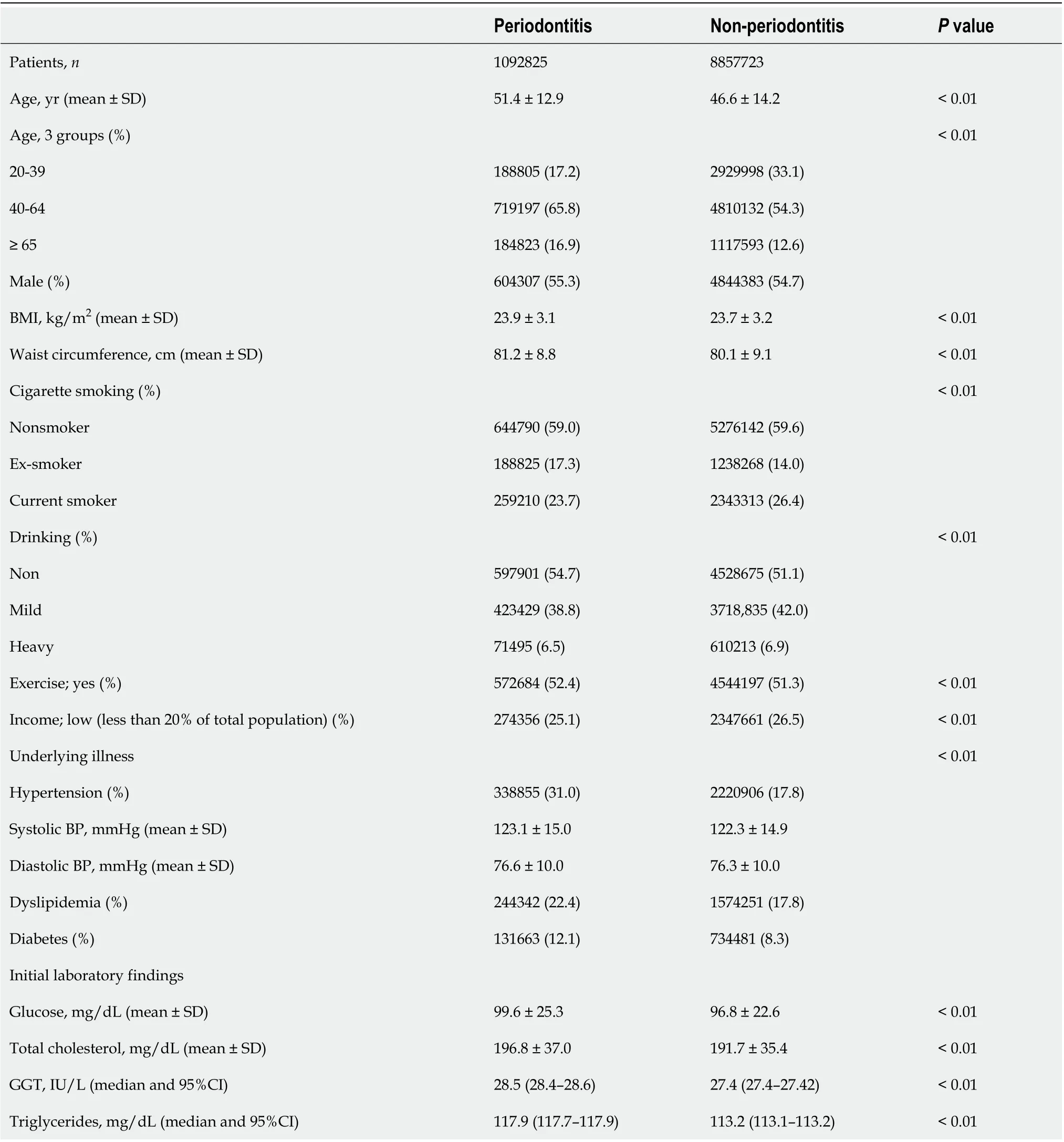
Table 1 Baseline characteristics of the study population

Table 2 The incidence and risk for inflammatory bowel disease in patients with periodontitis
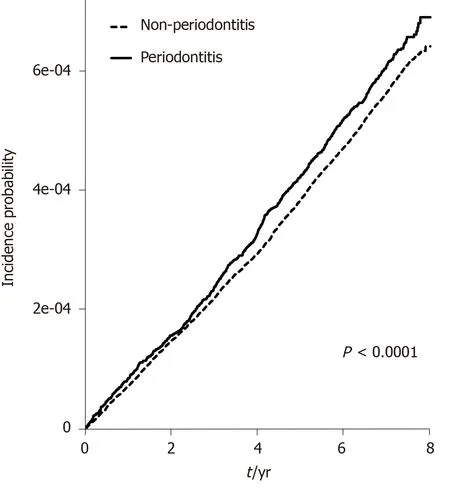
Figure 1 Cumulative incidence of ulcerative colitis in patients with and without periodontitis.
Risks of developing UC according to cigarette smoking behavior
We investigated the risks of developing UC in the periodontitis and non-periodontitis groups, respectively, according to smoking behavior (Figure 3). Ex-smokers in both groups had the highest risks of developing UC compared to nonsmokers without periodontitis, but the difference in the adjusted HRs between the periodontitis (adjusted HR: 1.667; 95%CI: 1.425-1.950) and non-periodontitis groups (adjusted HR: 1.740; 95%CI: 1.606-1.884) among ex-smokers was not significant. However, current smokers in the periodontitis group (adjusted HR: 1.255; 95%CI: 1.078-1.462) had a significantly higher risk of developing UC, but not those in the non-periodontitis group (adjusted HR: 0.946; 95%CI: 0.874–1.025) compared to nonsmokers without periodontitis. A significant difference in adjusted HRs was observed between the periodontitis and non-periodontitis groups among current smokers (Figure 3A). The significant risk of developing UC in current smokers with periodontitis (adjusted HR: 1.924; 95%CI: 1.197–3.092) was more pronounced in the elderly subgroup > 65 years than in nonsmokers without periodontitis (Figure 3B and C).
DISCUSSION
This population-based cohort study of approximately 10 million individuals reported that periodontitis significantly increased the risk of developing UC, but not CD, compared to those without periodontitis. The effect of periodontitis on the risk of developing UC was prominent, particularly among elderly male current smokers who drank alcohol and participated in reduced physical activity. In particular, current smoking and the presence of periodontitis had a synergistic effect on the occurrence of UC in the elderly. To the best of our knowledge, this is the largest epidemiological study demonstrating the impact of periodontitis on the development of IBD based on demographic and environmental factors.
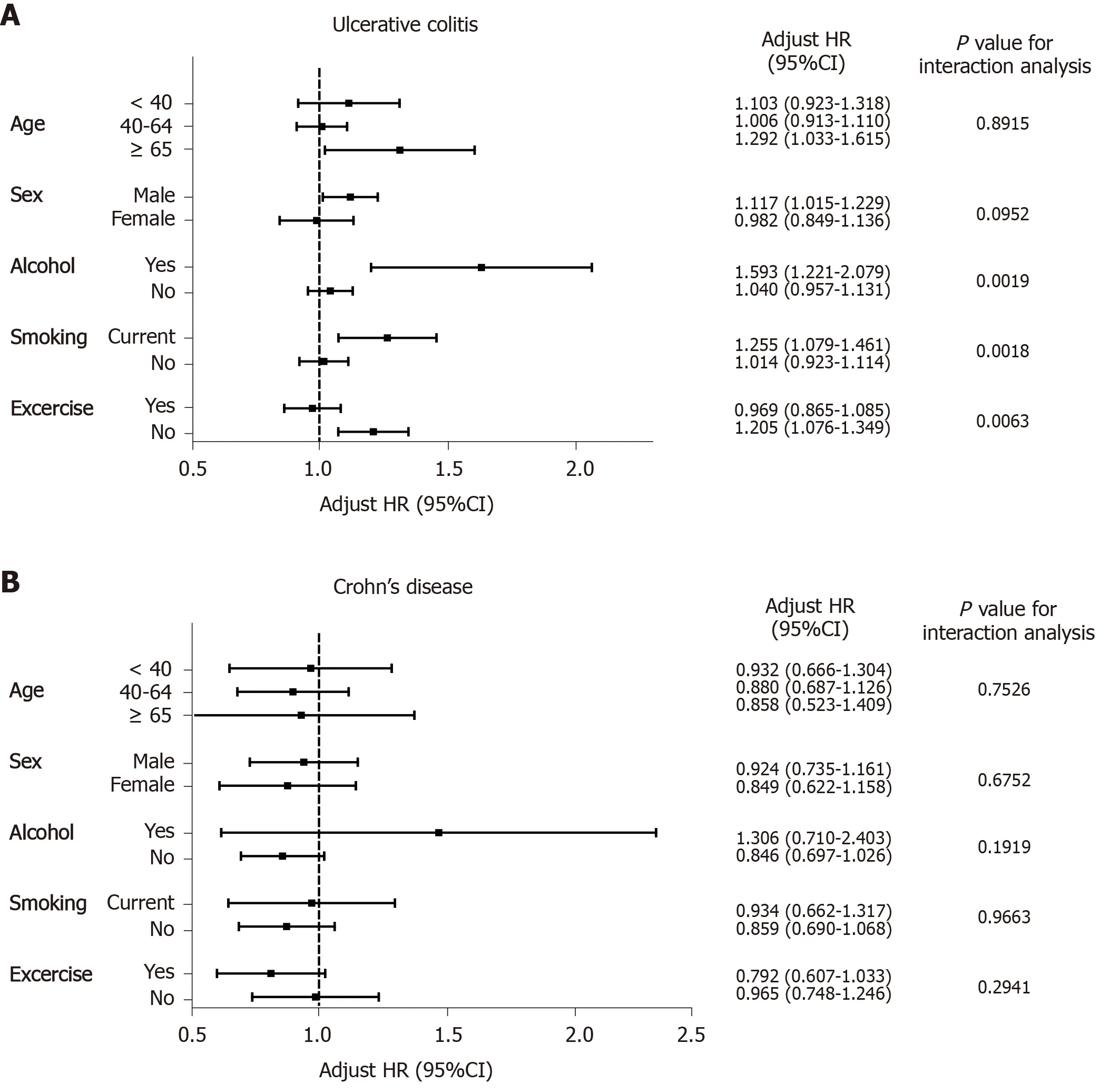
Figure 2 Subgroup analysis of the comparative risk of ulcerative colitis and Crohn’s disease in patients with periodontitis compared with those without periodontitis. Error bars represent 95% confidence intervals. A: Ulcerative colitis; B: Crohn’s disease. HR: Hazard ratio; CI: Confidence interval.
The risk for periodontitis among patients with IBD has been reported in recent studies[15,26-28]. In a matched-cohort study demonstrating the prevalence and relative risk of periodontitis, patients with CD were at a 1.36-fold increased risk for periodontitis than controls[29]. The relative risk of periodontitis is also significantly higher in patients with UC[30], especially in smokers[31], which suggests that periodontitis is an oral manifestation of IBD. Periodontitis may occur as a complication of IBD itself or as an adverse event related to IBD therapeutic agents. Changes in the host immune system in patients with a systemic disease may affect oral mucosal immunity. Subgingival microflora changes have been detected in patients with IBD and periodontitis[32], and dysregulation of the host immune system, such as in Th17 cells and the interleukin (IL)-23/IL-17 axis have been proposed to be involved in the pathophysiology of periodontitis related to IBD[33].
In contrast, there is little evidence regarding the risk of developing IBD in patients with periodontitis. A Taiwanese cohort study reported a 1.56-fold significantly higher risk of UC, but not CD, in 27000 patients with periodontal diseases, including acute periodontitis, chronic periodontitis, and gingivitis[34], which is comparable with our results in a nationwide study of 1 million subjects with chronic periodontitis. Our study has the strength of demonstrating the impacts of chronic periodontitis, which may reflect the dynamics of chronic inflammatory conditions and lifestyle factors, such as cigarette smoking, on the pathogenesis of IBD. Taken together, the risk of developing UC increased significantly in patients with periodontitis, although the relatively low HR for UC in the periodontitis group needs to be evaluated by epidemiologic studies in other countries.

Figure 3 The risk for developing ulcerative colitis with age and cigarette smoking behavior in the periodontitis and non-periodontitis groups. Error bars represent 95% confidence intervals. A: All ages; B: Age < 65; C: Age ≥ 65. HR: Hazard ratio.
The effect of periodontitis on the pathogenesis of UC may be associated with dysbiosis in the oral and intestinal microenvironments[35]. The role of the gut microbiota is critical in the pathogenesis of IBD in terms of nutrition, host immune response, and defense[36]. UC is associated with reduced microbial diversity and depletion ofBacteroidetesandFirmicutesin the gastrointestinal tract. Gut dysbiosis in IBD, particularly UC, is associated with changes in the salivary microbiome[37]. Therefore, oral hygiene and biofilms related to periodontitis might affect the initiation and perpetuation of inflammationviadysbiosis in the colon. In contrast, the dynamic interactions between the oral microenvironment and the development of intestinal inflammation in patients with CD are weak. In a recent population-based cohort study in Sweden, dental plaques were negatively associated with a 68% reduced risk of CD[38]. The dynamic impacts of oral hygiene on dysbiosis and chronic inflammation in the gastrointestinal tract should be clarified in further research.
We determined that the risk groups for UC related to periodontitis were elderly, male, alcohol drinking, current smoking, and reduced physical activity. These demographic and lifestyle factors that can alter oral hygiene have crucial effects on the development of UC among patients with periodontitis. Cigarette smoking may have a protective effect on the development of UC, while quitting smoking increases the risk of developing UC[39-42]. However, smoking and smoking cessation was not associated with disease course of UC[42]. Recent studies have demonstrated a dose-response relationship between quitting smoking and the risk of developing UC[11,43]. In line with previous results, ex-smokers had the highest risk of developing UC, regardless of the presence of periodontitis and age in this study. In contrast, current smoking effect on the prevention of UC is still controversial depending on subgroups such as ethnicity and gender. Interestingly, the comparative risk of developing UC in the elderly tended to be more pronounced in current smokers than in ex-smokers, suggesting that the synergistic effects of periodontitis and cigarette smoking increase the risk of elderly onset UC. Cigarette smoking causes changes in both oral and intestinal microbial composition[44,45], and may play a key role as an environmental cause of UCviaoral and gut dysbiosis. Cigarette smoking affects microbial diversity and composition resulting in decreases inProteobacteriaandBacteroidetesand increases inFirmicutes[46]. ATreponema denticolainfection is frequently detected in current smokers with periodontal disease[47]. Further research is needed to determine the combined effects of cigarette smoking and periodontitis on the pathogenesis of elderly onset UC, in terms of oral dysbiosis.
The incidence of UC shows a bimodal distribution in the age at onset[48-51], and the second peak of incidence in the elderly is closely related to the environmental etiologies of UC. Surprisingly, the age-specific incidence of UC is in a steady state between the ages of the 20 s to 60 s with the highest rates for men in their 60 s in a recent 30-year follow-up epidemiological study from South Korea[50]. The consistent evidence of ex-smokers related to the risk of UC development and the harmful synergistic effects of current cigarette smoking and periodontitis in the elderly provide an important clue to explain the role of environmental etiologies in the complex pathophysiology of elderly onset UC.
The present study had several limitations due to its retrospective design. First, the severity and disease extent of IBD could not be investigated. Second, the risk of developing IBD among patients with periodontitis was not adjusted by medication. Antibiotics are possible confounders in the relationship between periodontitis and IBD but are generally used within a short period in actual practice in this general population. It is assumed that the chaotic effects of antibiotics might be minimized considering the median follow-up period of more than 7 years. Use of corticosteroids and immunomodulatory agents could not be also identified due to the limitations of claims data. Third, the operational definition for the severity of periodontitis was not validated, although there was no significant difference in the comparative risk of developing UC based on the severity of periodontitis. Further prospective research is required to assess how the severity of periodontitis and oral dysbiosis affect the risk of developing UC.
CONCLUSION
Periodontitis was significantly associated with the risk of developing UC, but not CD. Current smoking superimposed the impacts of periodontitis on the occurrence of elderly onset UC. These findings suggest that adding cigarette smoking in the background of periodontitis are potential risk factors for elderly onset UC.
ARTICLE HIGHLIGHTS
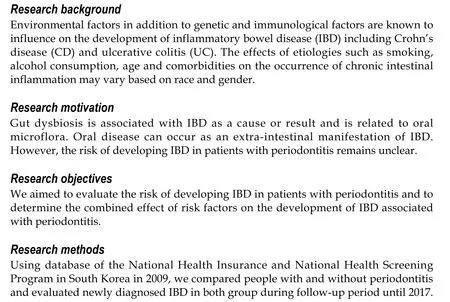

Research results
Out of 9950548 individuals, a total of 1092825 subjects (11.0%) had periodontitis. The periodontitis group was older and had a higher male proportion. During the median follow-up period of 7.26 years, people with periodontitis had a significantly higher risk of developing UC than those without periodontitis. In a subgroup analysis, current smokers aged 65 and older with periodontitis had a 1.9-fold increase in UC risk than non-smokers aged 65 and older without periodontitis.
Research conclusions
Periodontitis is highly associated with the risk of developing UC, especially in current smokers over 65. It suggests that periodontitis and current smoking are a potential combined risk factor for the development of elderly-onset UC.
Research perspectives
Based on the results of this study, we need future prospective studies to focus on the synergistic impacts of the environmental risk factors on elderly onset UC in terms of complex interaction of oral and intestinal microflora. Ultimately, it can lead to a better understanding of the pathogenesis of IBD.
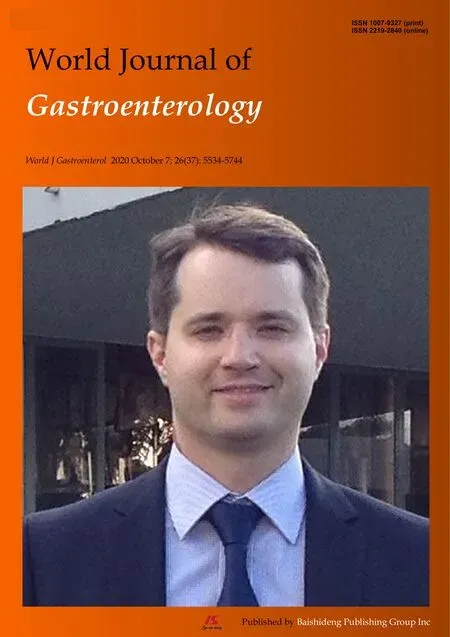 World Journal of Gastroenterology2020年37期
World Journal of Gastroenterology2020年37期
- World Journal of Gastroenterology的其它文章
- Artificial intelligence technologies for the detection of colorectal lesions: The future is now
- Transjugular intrahepatic portosystemic shunt in cirrhosis: An exhaustive critical update
- Abernethy syndrome in Slovenian children: Five case reports and review of literature
- Endoscopic retrograde cholangiopancreatography in the treatment of pancreaticopleural fistula in children
- Risk prediction rule for advanced neoplasia on screening colonoscopy for average-risk individuals
- Endoscopic ultrasound-fine needle biopsies of pancreatic lesions: Prospective study of histology quality using Franseen needle
